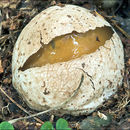Biology
provided by Arkive
Fungi are neither plants nor animals but belong to their own kingdom. They are unable to produce their own food through the process of photosynthesis, as plants do; instead, they acquire nutrients from living or dead plants, animals, or other fungi, as animals do. In many larger fungi (lichens excepted) the only visible parts are the fruit bodies, which arise from a largely unseen network of threads called 'hyphae'. These hyphae permeate the fungus's food source, which may be soil, leaf litter, rotten wood, dung, and so on, depending on the species (3).
The fruit bodies of the stinkhorn may grow solitarily or in groups, and are present from July to November (2). The young fruit bodies are edible, and are said to taste of peas (3); they can be eaten fried and are treated as a delicacy in Germany. The mysterious appearance of these 'eggs' led to the widespread belief that they were witches eggs or eggs of the Devil (2). Stinkhorns have been used in love potions and aphrodisiacs because of their phallic appearance, and to treat epilepsy, gout and rheumatism in central Europe. Some birds, snails and flies eat the mucous produced by the cap. Stinkhorn spores have been found in fly and bird dung; spores have been known to germinate inside flies, and the hyphae of the fungus grow outwards from the dead body of the fly (2).
Conservation
provided by Arkive
No conservation action has been targeted at this species.
Description
provided by Arkive
Its terrible foetid smell as well as an unmistakable appearance makes the stinkhorn one of the most easily recognised species of fungi (2). Young fruit bodies (the visible part of the fungus) are known as 'eggs', and have often been confused with real eggs. The phallic mature fruit body grows extremely rapidly from the egg, taking just 1 and a half hours to reach full size in one recorded case. The conical cap is olive green in colour and rapidly becomes slimy, developing an unpleasant smell; it has a honeycombed appearance (2).
WARNING: Many species of fungus are poisonous or contain chemicals that can cause sickness. Never pick and eat any species of fungus that you cannot positively recognise or are unsure about. Some species are deadly poisonous and can cause death within a few hours if swallowed.
Habitat
provided by Arkive
Found in broadleaved and coniferous woodlands (3) and parks, where it is associated with rotten wood (4). It also occurs in gardens, and cemeteries (2).
Range
provided by Arkive
Common throughout much of Europe; it is common in North America to the west of the Mississippi, but becomes rare in the east. It is also found in south-east Australia (2).
Threats
provided by Arkive
This fungus is not threatened.

